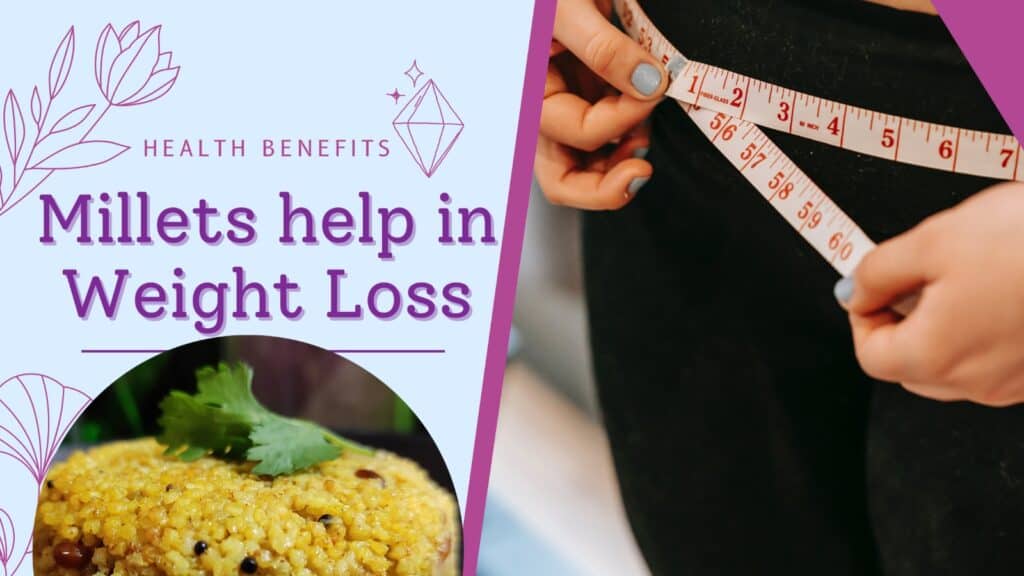Table of Contents
Health Benefits of Millet:
Before I start today, I will simply ask you a question from my heart.
Do you eat millet?
If you are health conscious and truly care about yourself and your family, you can definitely opt for millets and include them in your regular diet.
It was a time when millets were part of people’s diets during the 1960s. But slowly the millets started disappearing from our plates and moreover referred only to rice and wheat and that too refined based cereals. Between 1962 and 2010, India’s per capita consumption of millet fell drastically from 32.9 to 4.2 kg, while that of wheat almost doubled from 27 to 52 kg. (www.indiaspend.com). This led to less diversity in our regular food.
Have you ever heard of your grandparents suffering from lifestyle diseases like diabetes, obesity, and cardiovascular diseases? I think the answer will be an absolute ‘‘‘’ No’’’’.
I am sure, after going through this blog you will come to know about the amazing health benefits of millet.
1. Health Benefits of Millet in Controlling Diabetes:
As you know ‘‘‘’ seeing is believing’’’’. In the year 2019, my mother had to go for an eye operation and found that she was suffering from diabetes. The doctor refused to do the eye operation as the blood sugar level was beyond 200 after food. The situation was really challenging for me. My mother started taking millets in her regular diet and within 30 days the result was amazing. The eye operation was successful.
From that day, I had a belief and confidence from within and can say Millets are good for diabetes.
Millets play an important role in managing and controlling the blood sugar level in our bodies. Due to the high fiber content in millet, glucose is released into the blood in a very slow and steady manner. That means millet will not cause a sudden spike in blood sugar levels.
Now, let us understand the overall status of diabetes in India and around the globe. In India, as per a report, there are 77 million people who are affected by diabetes and which is the second highest in the world. As per the International Diabetes Federation, there are 463 million people who are affected by diabetes in the world. 10% of global health expenditure is spent on diabetes and it is also astonishing to see that 11,10,100 children and adolescents below 20 years have type 1 diabetes.
Seeing these estimated reports, it is concluded that Diabetes is a global emergency.
To give more evidence on how millets are good for diabetes, it is necessary to see the scientific study on millets. Recently in the year 2021, a systematic review and meta-analysis of the potential of millets for managing and reducing the risk of developing diabetes were done by a team of scientists from different countries. This analysis was done across different types of millets and the forms of processing and cooking.

From the analysis, it was found that long-term millet consumption showed a reduction in HbA1c, which is lower than a rice-based diet. This meta-analysis confirmed that the millets evaluated have strong potential in dietary management and prevention of diabetes.
More points to understand why millets are good for diabetes.
- Due to the presence of high dietary fiber, it takes more time for digestion.
- A person does not get hunger pangs between meals as it keeps them satiated for a longer time.
- Millets are composed of complex carbohydrates which digest slowly in the body.
Looking into the nutritional profile of millets, here are the 5 types of millets which you can choose for diabetes.
| Sl.No. | Millet | Carbohydrates | Fiber Content | C/F Ratio |
| 1 | Barnyard Millet | 65.6 | 13.6 | 4.82 |
| 2 | Browntop Millet | 61.37 | 12.5 | 4.90 |
| 3 | Little Millet | 65.6 | 7.6 | 8.63 |
| 4 | Foxtail Millet | 60.2 | 6.7 | 8.98 |
| 5 | Kodo Millet | 66.2 | 5.2 | 12.73 |
No doubt, millets are beneficial in managing and controlling diabetes. It can be included in the regular diet of non-diabetic people as a preventive approach.
2. Health Benefits of Millet in controlling Obesity:
Obesity is increasing at a fast rate because of lifestyle and unhealthy eating and giving more preference to refined cereal-based diets, including more packaged food that are high in sugar, salt, and fats, and taking a more high-calorie diet with low nutrients. It is reported that obesity or being overweight is the major problem faced by city dwellers as compared to rural people.
In the first-ever large-scale survey conducted by ICRISAT, 15,500 people were interviewed on millet consumption in India. In this survey, it was found that the single reason for eating millet was due to health problems (30% of people responded) and the next reason was people wanting to lose weight accounting for about 15%. This shows that millets have the potential to help people in shedding their extra kilos/weight.
The specific contents in the millet triggering weight loss in the body are dietary fiber, calorie content, policosanols, and tryptophan.

Let us see the function of dietary fiber in the millets that helps in weight loss.
- Due to high dietary fiber, carbohydrate absorption is slowed and glucose tolerance is reduced.
- Dietary fiber helps in water absorption.
- It acts as a detoxifying agent and helps in binding of the toxins.
- Food transit time in the intestine is increased due to dietary fiber.
When it comes to weight loss, the calorie content of the food is crucial and taking fewer calories than our body truly burns can help us in losing weight.
Policosanols are found in Sorghum that help in reducing cholesterol in our body. Study shows that the presence of policosanols in food helps in weight loss. Basically, policosanols are a group of high molecular weight (20-30 carbon) aliphatic primary alcohols found in plant epicuticular waxes. Choosing whole grain is beneficial for our body as whole sorghum contains about 69.7 mg/100 gm of policosanols whereas polished sorghum contains about 9.8 mg/100gm.
The presence of Tryptophan in the Foxtail Millet is responsible for slower digestion and prevents us from taking excess calories in our diet and helps us in weight loss. Tryptophan is an alpha-amino acid that’s involved in protein synthesis.
In a study, it was found that consuming millet reduced the body mass index (BMI) by 7% in people who were obese and overweight. The results were based on the consumption of 50 to 200 gm of millet per day for a duration of 21 days to 3 months.
3. Health Benefits of Millet for Celiac Diseases:
Celiac disease is a digestive disorder that damages the small intestine, triggered by eating food containing gluten. Gluten is a protein found in wheat, rice, and many more grains. Gluten makes the dough elastic.
When someone with celiac disease eats gluten food, their body overreacts to the protein and damages the villi of the small intestine.
Celiac disease is found in 1 out of 100 people worldwide. So, millets are becoming a part of the diet of celiac patients.
4. Millet detoxifies the body
Millets contain phenols and antioxidants and it helps to clean up toxins from the body.
5. Health Benefits of Millets – Helps to protect against heart diseases
Millets contain essential fats, just the right amount to give our body natural fat. This helps prevent fat from depositing over muscles and avoids high cholesterol, heart strokes, and heart-related diseases.

A study was led by ICRISAT with 5 organizations analyzing the data of 19 studies with nearly 900 people. The study showed that consuming millets reduced total cholesterol by 8%. There was nearly a 10% decrease in low and very low-density lipoprotein cholesterol and triacylglycerol levels in the blood. It was also found that consuming millets decreased blood pressure with diastolic blood pressure decreasing by 5%.
6. Millets help in preventing cancer
Millets are effective in the prevention of cancer initiation and progression. Millets contain fibers and phytonutrients, the combination of which is believed to reduce the risk of developing colon cancer.
7. Millets help to slow the aging in the body
Everyone likes to look and remain young always. Millets are a good source of antioxidants. The high amount of antioxidants present in millet fights the free radicals present in the body which slows down the aging process.
8. Health Benefits of Millet – Improve skin elasticity
Millets are rich in amino acids called L-Lysine and P-Proline. Millets help to create collagen in the body, a substance that gives structure to the skin and tissue. Thus eating millet fortifies the collagen level to improve skin elasticity and makes it less prone to wrinkles.
9. Millets help in preventing anemia
In India, Anaemia is prevalent and it is mostly found in children, pregnant and non-pregnant women. Millets are the best source of iron. Iron is beneficial in preventing anemia. Pearl Millet (Bajra) contains the highest iron content (11 mg per 100gm grains). Consumption of Pearl Millet prevents iron deficiency in the body.
10. Millets help in reducing hypertension
Millets help in preventing the oxidation of low-density lipoprotein thus reducing hypertension.
11. Millets act as prebiotics and improve gut health
We know that millets are rich in dietary fiber, both soluble and insoluble. The insoluble dietary fiber in millets is known as a prebiotic that supports bacteria in our digestive system.
Video on Health Benefits of Millet in Hindi
Author: Tapas Chandra Roy, A Certified Farm Advisor on Millets, ‘Promoting Millets from Farm to Plate’ and an Author of the book -” Millet Business Ideas-Empowering Millet Startups”. In a mission to take the forgotten grains- Millets to Millions. To remain updated on my blogs on Millets please subscribe to my newsletter and for any queries please feel free to write to [email protected]


